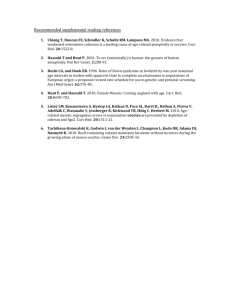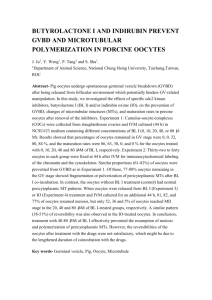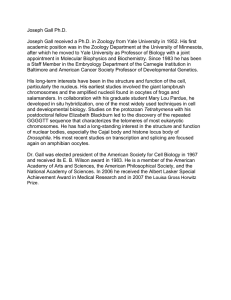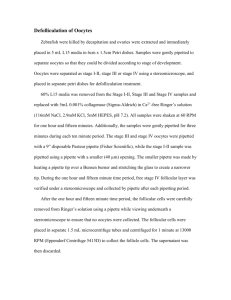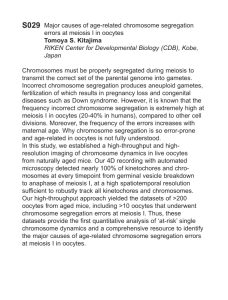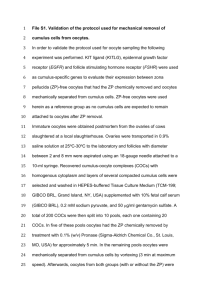British Journal of Pharmacology Toxicology 3(1): 29-32, 2012 ISSN: 2044-2467
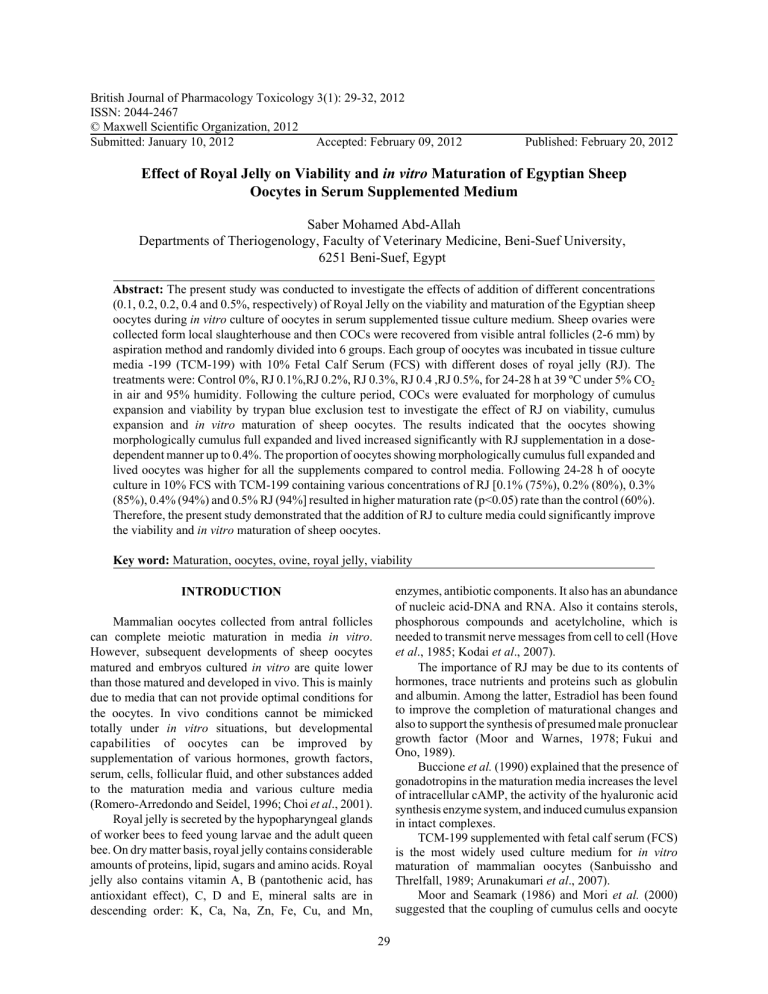
British Journal of Pharmacology Toxicology 3(1): 29-32, 2012
ISSN: 2044-2467
© Maxwell Scientific Organization, 2012
Submitted: January 10, 2012 Accepted: February 09, 2012 Published: February 20, 2012
Effect of Royal Jelly on Viability and in vitro Maturation of Egyptian Sheep
Oocytes in Serum Supplemented Medium
Saber Mohamed Abd-Allah
Departments of Theriogenology, Faculty of Veterinary Medicine, Beni-Suef University,
6251 Beni-Suef, Egypt
Abstract: The present study was conducted to investigate the effects of addition of different concentrations
(0.1, 0.2, 0.2, 0.4 and 0.5%, respectively) of Royal Jelly on the viability and maturation of the Egyptian sheep oocytes during in vitro culture of oocytes in serum supplemented tissue culture medium. Sheep ovaries were collected form local slaughterhouse and then COCs were recovered from visible antral follicles (2-6 mm) by aspiration method and randomly divided into 6 groups. Each group of oocytes was incubated in tissue culture media -199 (TCM-199) with 10% Fetal Calf Serum (FCS) with different doses of royal jelly (RJ). The treatments were: Control 0%, RJ 0.1%,RJ 0.2%, RJ 0.3%, RJ 0.4 ,RJ 0.5%, for 24-28 h at 39 ºC under 5% CO
2 in air and 95% humidity. Following the culture period, COCs were evaluated for morphology of cumulus expansion and viability by trypan blue exclusion test to investigate the effect of RJ on viability, cumulus expansion and in vitro maturation of sheep oocytes. The results indicated that the oocytes showing morphologically cumulus full expanded and lived increased significantly with RJ supplementation in a dosedependent manner up to 0.4%. The proportion of oocytes showing morphologically cumulus full expanded and lived oocytes was higher for all the supplements compared to control media. Following 24-28 h of oocyte culture in 10% FCS with TCM-199 containing various concentrations of RJ [0.1% (75%), 0.2% (80%), 0.3%
(85%), 0.4% (94%) and 0.5% RJ (94%] resulted in higher maturation rate (p<0.05) rate than the control (60%).
Therefore, the present study demonstrated that the addition of RJ to culture media could significantly improve the viability and in vitro maturation of sheep oocytes.
Key word: Maturation, oocytes, ovine, royal jelly, viability
INTRODUCTION
Mammalian oocytes collected from antral follicles can complete meiotic maturation in media in vitro .
However, subsequent developments of sheep oocytes matured and embryos cultured in vitro are quite lower than those matured and developed in vivo. This is mainly due to media that can not provide optimal conditions for the oocytes. In vivo conditions cannot be mimicked totally under in vitro situations, but developmental capabilities of oocytes can be improved by supplementation of various hormones, growth factors, serum, cells, follicular fluid, and other substances added to the maturation media and various culture media
(Romero-Arredondo and Seidel, 1996; Choi et al ., 2001).
Royal jelly is secreted by the hypopharyngeal glands of worker bees to feed young larvae and the adult queen bee. On dry matter basis, royal jelly contains considerable amounts of proteins, lipid, sugars and amino acids. Royal jelly also contains vitamin A, B (pantothenic acid, has antioxidant effect), C, D and E, mineral salts are in descending order: K, Ca, Na, Zn, Fe, Cu, and Mn, enzymes, antibiotic components. It also has an abundance of nucleic acid-DNA and RNA. Also it contains sterols, phosphorous compounds and acetylcholine, which is needed to transmit nerve messages from cell to cell (Hove et al ., 1985; Kodai et al ., 2007).
The importance of RJ may be due to its contents of hormones, trace nutrients and proteins such as globulin and albumin. Among the latter, Estradiol has been found to improve the completion of maturational changes and also to support the synthesis of presumed male pronuclear growth factor (Moor and Warnes, 1978; Fukui and
Ono, 1989).
Buccione et al.
(1990) explained that the presence of gonadotropins in the maturation media increases the level of intracellular cAMP, the activity of the hyaluronic acid synthesis enzyme system, and induced cumulus expansion in intact complexes.
TCM-199 supplemented with fetal calf serum (FCS) is the most widely used culture medium for in vitro maturation of mammalian oocytes (Sanbuissho and
Threlfall, 1989; Arunakumari et al ., 2007).
Moor and Seamark (1986) and Mori et al.
(2000) suggested that the coupling of cumulus cells and oocyte
29
Br. J. Pharmacol. Toxicol., 3(1): 29-32, 2012 is important for the uptake of nutrients by oocytes during maturation in culture medium and to facilitate the transport of signals into and out of the oocyte.
Furthermore, Cox et al.
(1993), Chauhan et al.
(1997) and
Ali and Sirard (2002) reported that the presence of cumulus cells during IVM of animal oocytes may provide an energy source or may produce factor(s) or hormones capable of regulating maturation.
Trypan blue stain has been used previously to detect oocyte viability (Freshney, 2000) and Dead oocytes displayed a dark blue ooplasm with translucent cumulus cells. Trypan blue exclusion test provides an assessment of cell membrane integrity as those cells with damaged or non-intact cell membranes permit the passage of the trypan blue toward the nucleus of oocyte. Abd-Allah et al.
(2008) reported that the developmental ability of camel oocytes was not affected by trypan blue staining.
The present study was designed to evaluate the effect of addition of RJ to culture media (TCM-199) on viability, cumulus expansion and in vitro maturation of
Egyptian sheep oocytes.
in TCM-199+10% FCS+50
: g/mL gentamycine sulpahate. The treatment included different concentrations of RJ with addition of 10% FCS. TCM-199 with serum supplementation formed the control. The treatments were:
C
Control
C
RJ 0.1%
C
RJ 0.2%
C
RJ 0.3%
C
RJ 0.4%
C
RJ 0.5%
For all experiments, 10 oocytes were transferred separately into a 50 uL drop of TCM-199, covered with sterile mineral oil in a polystyrene culture dish (3.5 mm ×
10 mm) which had been previously kept for about 2 h in a CO
2
incubator before the oocytes were added. The oocytes were cultured for 24-28 h at 39 o C in an atmosphere of 5% CO
2
in air with 95% humidity.
MATERIALS AND METHODS
Chemicals: All materials were purchased from Sigma
Chemical Company (St. Louis, MO, USA) unless otherwise indicated.
Royal jelly: Pure royal jelly capsules were used in this study (Pharco Pharmaceuticals Co., Egypt). Each capsule
(1000 mg) was dissolved in 10 mL double distilled water to get concentration of 100 mg/mL.
Morphological evaluation of cumulus cells expansion:
Following the culture period, the COCs cultured using different concentrations of RJ with serum supplementation were evaluated morphologically for cumulus expansion using procedures described previously for bovine (Lorenzo et al ., 1994). The matured oocytes were scored for granulose-oocyte cell expansion as previously described for bovine by Lorenzo et al . (1994) with minor modification: CE+ for granulosa-full expanded oocytes, CE+/- for granulose- partially expanded oocytes, (whenever there were few expansion of cumulus layers or cumulus cells were nonhomogeneously spread and clustered cells were still observed or moderate expansion of cumulus layers) and
CEfor granulosa-non expanded oocytes.
Oocyte recovery: This study was conducted at the In vitro Fertilization Laboratory, Faculty of Veterinary
Medicine, Beni-Suef University, Egypt. From January to
March 2011, sheep ovaries (n = 180) were collected at the moment of slaughter at a local abattoir in Cairo, stripped of fat tissue and ligaments, and rinsed in saline solution
(37ºC). Sheep oocytes were obtained by aspiration of 2-6 mm follicles from ovaries collected from a slaughterhouse. Only oocytes having a dense cumulus cell mass and homogeneous cytoplasm were selected for the study. Oocytes were washed 3 times with Dulbecco’s phosphate-buffered saline. For all culture experiments, maturation of oocytes took place in TCM-199+10%
FCS+50
: g/mL gentamycine sulpahate.
Viability evaluation of cumulus cell expansion using the trypan blue exclusion test: Following the culture period, the COCs cultured using different concentrations of RJ with serum supplementation were evaluated the viability of all grades of cumulus expanded oocytes using procedures described previously for camel oocytes (Abd-
Allah et al ., 2008). All classes of oocytes were examined for viability using the trypan blue exclusion test. Cumulus expanded oocytes were categorized on the basis of the degree of dye exclusion. Unstained oocytes were classified as live and fully stained oocytes as dead.
Statistical analysis: Data were analyzed using Chi-square analysis (Snedecor and Cochran, 1980).
In vitro Maturation (IVM): Oocytes with a homogenous and evenly granulated cytoplasm and three or more layers of cumulus cells were placed into drops (100
:
L) of maturation medium under paraffin oil, and cultured in 35 mM petri-dishes at 39ºC under an atmosphere of 5% CO
2 in air, 95% humidity, for 28 h. The oocytes were matured
RESULTS
Cumulus cell expansion, viability and in vitro maturation rate of ovine oocytes were found in the present
30
Br. J. Pharmacol. Toxicol., 3(1): 29-32, 2012
Table 1:Effect of different concentrations of royal jelly on cumulus expansion, viability and maturation rate of sheep oocytes in TCM-199
Morphological observation Trypan blue exclusion test
Treatment
TCM-199 (control)
TCM+RJ 0.1%
TCM+RJ 0.2%
TCM+RJ 0.3%
No. of COCs
100
100
100
100
Cumulus expansion
------------------------------------------
CE+
30% a
(30/100)
40% b
CE+/-
20%
30% a
(20/100) b
CE-
50% a
(50/100)
30% b
(40/100)
45% b
(45/100)
50% b
(30/100)
35% b
(35/100)
40%
(30/100)
20% b
(20/100)
10% b
Live oocytes
------------------------------------------
CE+
76.6.3% a
(23/30)
87.5% b
CE+/-
75% a
(12/20)
83.3% b
CE-
50% a
(25/50)
50% b
(35/40)
88.8% b
(40/45)
90% b
(25/30)
82.8% b
(29/35)
85% b
(15/30)
55% b
(11/20)
60% b
Maturation rate
60% a
(60/100)
75% b
(75/100)
80% b
(80/100)
85% b
TCM+RJ 0.4%
TCM+RJ 0.5%
100
100
(50/100)
55% b
(55/100)
55% b
(55/100)
(40/100)
45% b
(45/100)
45% b
(45/100)
(10/100)
5% b
(5/100)
5% b
(5/100)
(45/50)
92.7% b
(51/55)
92.7% b
(51/55)
(34/40)
88.8% b
(40/45)
88.8% b
(40/45)
(6/10)
60% b
(3/5)
60% b
(3/5)
(85/100)
94% b
(94/100)
94% b
(94/100)
Values within column with different superscript were significantly different at p<0.05; CE+: Cumulus-full expanded oocytes; CE+/-: Cumulus-partially expanded oocytes (whenever there were few expansion of cumulus layers or cumulus cells were non-homogeneously spread and clustered cells were still observed or moderate expansion of cumulus layers); CE-: Cumulus-non expanded oocytes study to be activated by the addition of RJ plus FCS to the culture medium (TCM-199).
A total of 600 cultured grade oocytes were recovered from 180 ovaries (3.3 per ovary). At the end of experiment, the proportion of COCs showing different grades of cumulus expansion, viability of oocytes and in vitro maturation of oocytes with different treatment groups of RJ are presented in Table 1.
Compared to control media, supplementation of RJ at all concentrations showed a significantly higher (p<0.05) full cumulus expansion of CE+ grade. The proportion of oocytes showing full expanded cumulus cells and viable
(CE+) increased with RJ supplementation in a dosedependent manner up to 0.4% (which also showed the highest CE+ cumulus expansion). However, at 0.5% RJ further increase was not seen in addition, and there were no differences between different doses of RJ supplementation.
The proportion of viable ovine oocytes was higher for all the supplements dependent effect of RJ supplementation (Table 1).
Following 24-28 h of oocyte culture in 10% FCS with
TCM 199 containing various concentrations of RJ [0.1%
(75%), 0.2% (80%), 0.3% (85%), 0.4% (94%) and 0.5%
RJ (94%] resulted in higher maturation rate (p<0.05) rate than the control (60%).
demonstrated that RJ at different concentrations when combined with serum supplements has a beneficial effect on the in vitro maturation.
The proportion of oocytes showing CE+ cumulus expansion, viability and in vitro maturation of ovine oocytes was higher for all the supplements dependent effect of RJ supplementation. Therefore, the higher maturation rate in vitro of sheep oocytes in the present work might be attributed to some factors in RJ composition such as gonadotropins and essential amino acids that stimulate DNA and RNA synthesis and enhance cell division in addition, increases the level of intracellular cAMP, the activity of the hyaluronic acid synthesis enzyme system, and induced cumulus expansion in intact complexes.
The results of the present study indicate that cumulus expansion of sheep oocytes are significantly higher when they are cultured in a medium (10% FCS with TCM 199) supplemented with various doses (0.1, 0.2, 0.3, 0.4, 0.5%, respectively) than without RJ. However, there were no differences between different doses of RJ supplementation.
The cumulus expansion of the sheep oocytes obtained in the present study is similar to previous studies of Farag et al.
(2009) on sheep and Abd-Allah (2011) on buffaloes.
CONCLUSION
DISCUSSION
In this report, RJ at different concentrations was employed in TCM-199 media, to analyze the effects exerted by RJ on in vitro maturation of sheep oocytes using a 5% CO
2
in air environment.
The use of serum as a supplement in the in vitro maturation media for oocytes seems to be controversial because of the variety of substances that the sera obtained from different sources may contain which may have beneficial or harmful effects. The present study
The study showed that supplementation of RJ in maturation media positively affected cumulus expansion and maturation so it could be concluded that RJ could be used as a beneficial additive to synthetic culture media used for in vitro maturation in sheep oocytes.
REFERENCES
Abd-Allah, S.M., 2011. Laboratory Production of Buffalo
Embryos. 1st Edn., LAP Lambert Publishing House,
Germany, pp: 217.
31
Abd-Allah, S.M., A.A.Y. Khalil and K.M. Ali, 2008. The use of trypan blue staining to select the developmentally competent dromedary camel oocytes and its effect on in vitro maturation rate. In:
Proceedings of the Twentieth Annual Scientific
Conference of the Egyptian Society for Animal
Reproduction and Fertility, 2008, Fayoum, Cairo:
ESARF, pp: 207-218.
Ali, A. and M.A. Sirard, 2002. Effect of the absence or presence of various protein supplements on further development of bovine oocytes during in vitro maturation. Biol. Reprod., 66: 901-905.
Arunakumari, G., R. Vagdevi, B.S. Rao, B.R. Naik, K.S.
Naidu, R.V.S. Kumar and V.H. Rao, 2007. Effect of hormones and growth factors on in vitro development of sheep preantral follicles. Small Rumin. Res., 70:
93-100.
Buccione, R., A.C. Schroeder and J.J. Eppig, 1990.
Interactions between somatic cells and germ cells throughout mammalian oogenesis. Biol. Reprod., 43:
543-547.
Chauhan, M.S., P., Palta, S.K., Das, P.K. Katiyar and
M.L. Madan, 1997. Replacement of serum and hormone additives with follicular fluid in the IVM medium: Effects on maturation, fertilization and subsequent development of buffalo oocytes in vitro .
Theriogenology, 48: 461-469.
Choi, Y.H., E.M. Seidel, G.E. Carnevale . and E.L Squire,
2001. Effects of gonadotropins on bovine oocytes matured in TCM-199. Theriogenology, 56: 661-670.
Cox, J.F., J. Hormazabal and A. Santa Maria, 1993.
Effect of the cumulus on in vitro fertilization of bovine matured oocytes. Theriogenology, 40:
1259-1267.
Farag, I.M., S.M. Girgis, W.K.B. Khalil, N.H.A. Hassan,
A.A.M Sakr, S.M. Abd Allah and N.I. Ali, 2009.
Effect of hormones, culture media and oocyte quality on in vitro maturation of Egyptian Sheep oocytes. J.
Appl. Biosci., 24: 1520-1534.
Freshney, R.I., 2000. Culture of Animal Cells: A Manual of Basic Techniques. 4th Edn., Wiley-Liss, New
York, pp: 187-196.
Br. J. Pharmacol. Toxicol., 3(1): 29-32, 2012
Fukui, Y. and H. Ono, 1989. Effects of sera, hormones and granulosa cells added to culture medium for in vitro maturation, fertilization, cleavage and development of bovine oocytes. J. Rep. Fertil., 86:
501-506.
Hove, S.R., P.S. Dimick and A.W. Benton, 1985.
Composition of freshly harvested and commercial royal jelly. J. Apic. Res., 24:52-61.
Kodai, T., K, Umebayashi, T. Nakatani, K. Ishiyama and
N. Noda, 2007. Compositions of royal jelly II.
Organic acid glycosides and sterols of the royal jelly of honeybees ( Apis mellifera ). Chem. Pharm. Bull.,
55: 1528-1531.
Lorenzo, P.L., M.J. Lorenzo, J.C. Illera and M. Illera,
1994. Enhancement of cumulus expansion and nuclear maturation during bovine oocyte maturation in vitro by the addition of epidermal growth factors and insulin-like growth factors. J. Rep. Fertil., 101:
697-701.
Moor, R.M. and R.F. Seamark, 1986. Cell signaling, permeability and microvasculatory changes during antral follicles development in mammals. J. Dairy
Sci., 69: 927-943.
Moor, R.M. and G.M. Warnes, 1978. Effect of oocytes maturation in mammals. In: Crighton, D.B.,
G.R. Foxcroft, N.B. Haynes and G.E. Lamming,
(Eds.), Control of Ovulation. Butterworths, London, pp: 159-176.
Mori, T., T. Amano and H. Shimizu, 2000. Roles of gap junctional communication of cumulus cells in cytoplasmic maturation of porcine oocytes cultured in vitro . Biol. Reprod., 62: 913-919.
Romero-Arredondo, A. and G.E. Seidel Jr., 1996. Effects of follicular fluid during in vitro maturation of bovine oocytes on in vitro fertilization and early embryonic development. Biol. Reprod., 55: 1012-1016.
Sanbuissho, A. and W.R. Threlfall, 1989. The effect of estrous cow serum on the maturation and fertilizability of bovine follicular oocytes in vitro .
Theriogenology, 31: 693-699.
Snedecor, G.W. and W.F. Cochran, 1980 . Statistical
Methods. 7th Edn., Iowa State University Press,
Ames. IA, pp: 508.
32

